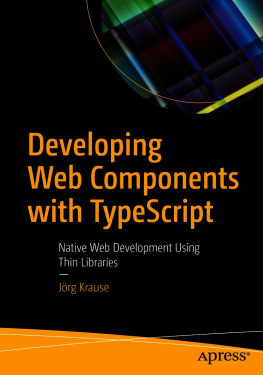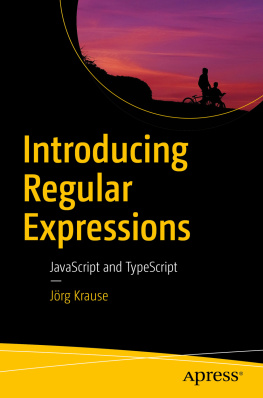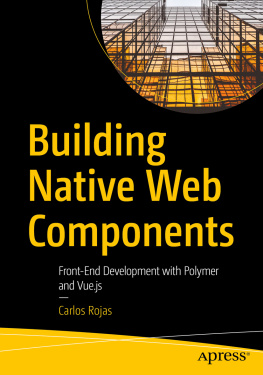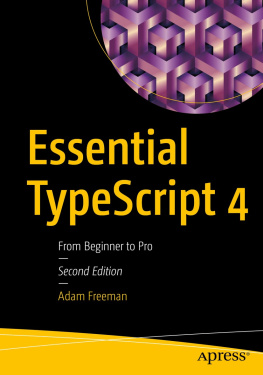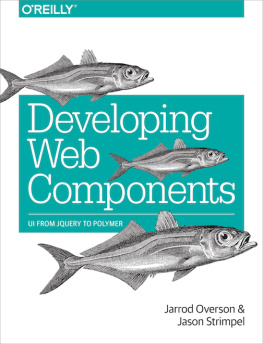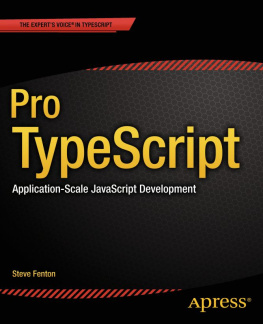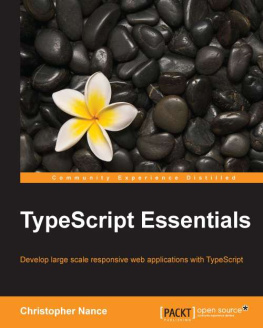Jörg Krause - Developing Web Components with TypeScript Native Web Development Using Thin Libraries
Here you can read online Jörg Krause - Developing Web Components with TypeScript Native Web Development Using Thin Libraries full text of the book (entire story) in english for free. Download pdf and epub, get meaning, cover and reviews about this ebook. year: 2021, publisher: Apress, genre: Computer. Description of the work, (preface) as well as reviews are available. Best literature library LitArk.com created for fans of good reading and offers a wide selection of genres:
Romance novel
Science fiction
Adventure
Detective
Science
History
Home and family
Prose
Art
Politics
Computer
Non-fiction
Religion
Business
Children
Humor
Choose a favorite category and find really read worthwhile books. Enjoy immersion in the world of imagination, feel the emotions of the characters or learn something new for yourself, make an fascinating discovery.
- Book:Developing Web Components with TypeScript Native Web Development Using Thin Libraries
- Author:
- Publisher:Apress
- Genre:
- Year:2021
- Rating:4 / 5
- Favourites:Add to favourites
- Your mark:
- 80
- 1
- 2
- 3
- 4
- 5
Developing Web Components with TypeScript Native Web Development Using Thin Libraries: summary, description and annotation
We offer to read an annotation, description, summary or preface (depends on what the author of the book "Developing Web Components with TypeScript Native Web Development Using Thin Libraries" wrote himself). If you haven't found the necessary information about the book — write in the comments, we will try to find it.
Jörg Krause: author's other books
Who wrote Developing Web Components with TypeScript Native Web Development Using Thin Libraries? Find out the surname, the name of the author of the book and a list of all author's works by series.
Developing Web Components with TypeScript Native Web Development Using Thin Libraries — read online for free the complete book (whole text) full work
Below is the text of the book, divided by pages. System saving the place of the last page read, allows you to conveniently read the book "Developing Web Components with TypeScript Native Web Development Using Thin Libraries" online for free, without having to search again every time where you left off. Put a bookmark, and you can go to the page where you finished reading at any time.
Font size:
Interval:
Bookmark:
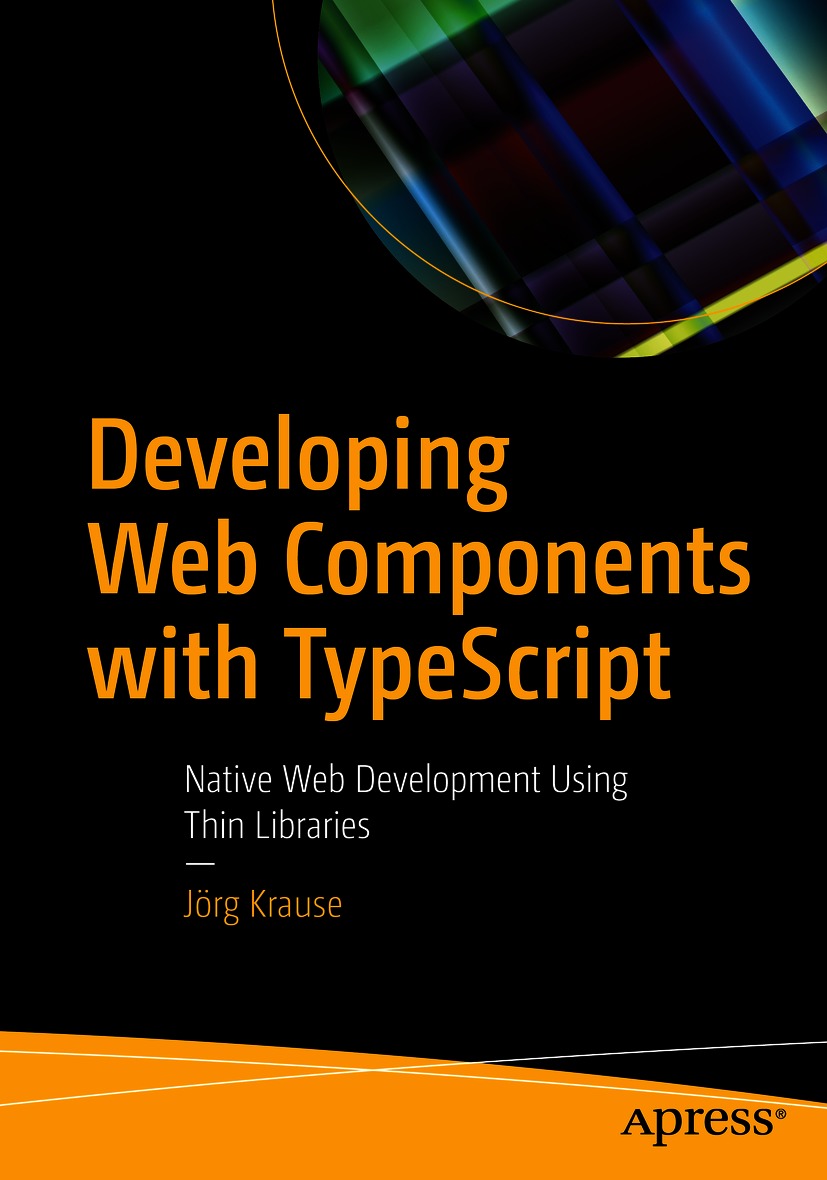

Any source code or other supplementary material referenced by the author in this book is available to readers on GitHub via the books product page, located at www.apress.com/978-1-4842-6839-1 . For more detailed information, please visit www.apress.com/source-code .
Writing outstanding code requires a mixture of craftsmanship, engineering, and art. To master all of this, one need a lot of time in front of a computer.
For all people around me accepting my focus.
This book explains Web Components. Additionally, it shows how to create a simple and small layer (a so-called thin library) around the native HTML 5 API to make your life as a developer a lot easier. This library is available as an open source project called @nyaf (Not Yet Another Framework). Its not a requirement, but it significantly reduces the hurdles for using Web Components and avoids the jump into full-blown frameworks and libraries such as Angular or React.
This book is aimed at both beginners and experienced web developers. The code is mainly TypeScript. A few examples are pure ECMAScript.
In any case, I tried not to ask any prerequisites or conditions of the reader. You do not need to be a computer scientist or in perfect command of a language; you dont need to know rocket science. No matter in what context you have encountered Web Components, you should be able to read this text. However, the most benefit from this book gets everybody already working on front-end stuff. Those overwhelmed with frameworks, techniques, and monstrous project structures will learn what modern web development has to offer. Nowadays all modern browsers are able to execute ES2015 and above natively, and transpilers such as Babel or TypeScript make it easy to adapt.
A machine with NodeJs v10+ installed. Any desktop OS will do it, whether as Windows, MacOS, or Linux. Windows users can use any shell, WSL or CMD, or PowerShell. Of course, any shell on Linux is good enough, too.
An editor to enter code. I recommend using Visual Studio Code. It runs on all mentioned operating systems. Webstorm is also an amazingly powerful editor.
A folder where the project is created. This is easy enough, but keep your environment clean and organized like a pro.
This book comes with a lot of examples and demo code. They are available on GitHub at https://github.com/joergkrause/webcomponent-book . The folders are structured following the book, chapter by chapter.
If youre relatively new to the web development field, test your knowledge by cloning the repo, bringing the examples to life, and watching the outcome. Read the text and add your own stuff once you know that the environment is up and running.
I have years of experience with Web Components. After several projects, smaller and bigger ones, my frustration was growing over the lack of support for simple tasks and the burden of huge frameworks that intentionally solve these burdens but come with an overwhelming amount of additional features. None of the frameworks felt right. I suspected that most developer support code has a similar trigger, so I decided to start my own library project.
A full description is available in the Appendix. The projects home is https://nyaf.comzept.de . Its open sourced under the MIT license and available on GitHub at https://github.com/joergkrause/nyaf .
Now Im on a mission. I want you to be able to learn the basics and avoid fat code as a fundamental part of your own work. There are some fields where it makes sense to add library stuff. Machine learning, artificial intelligence, and business intelligence are good examples. Front-end development is, honestly, not one of those fields. If you feel the need for help, then its just because you dont know enough. Thats the hard truth, but thats how it is. Once you master your field, youll see that a lot projects sell you stuff you dont need, create dependencies, and lock you in their environments. Its business, after all. But if you become an expert, youll unchain yourself from this stuff and this will improve the quality and elegance of your code.
Whenever you see a professional doing astonishing things or being a bit above the average, remember that its simply hard work. Nothing else. Talent helps, coincidences might happen, luck is possible. But for 99% of people, none of these things work. Hard work is the key.
Id like to thank my family first for understanding that projects like this, along with the daily work on code, require a lot more time than just 9-to-5. I really appreciate silent nights at the computer.
Also, again, the team at Apress was very helpful during this project, with the right mixture of time and pressure to get it done on schedule. Thank you all for the opportunity to write about a subject I really care about a lot.
Sometimes its hard, but there is always a way to see things positively. Even the biggest catastrophes may have an upside. Looking straight into the darkness might make it hard to see this. But there is one, for sure. This book and the library code used as the foundation were written during the pandemic in 2020. The upside was the leisure time not spent with friends, at holidays, or other activities. Not good, of course, but some new things learned, some pieces tried, some more lines writtenyou get the idea, I hope.
Font size:
Interval:
Bookmark:
Similar books «Developing Web Components with TypeScript Native Web Development Using Thin Libraries»
Look at similar books to Developing Web Components with TypeScript Native Web Development Using Thin Libraries. We have selected literature similar in name and meaning in the hope of providing readers with more options to find new, interesting, not yet read works.
Discussion, reviews of the book Developing Web Components with TypeScript Native Web Development Using Thin Libraries and just readers' own opinions. Leave your comments, write what you think about the work, its meaning or the main characters. Specify what exactly you liked and what you didn't like, and why you think so.

